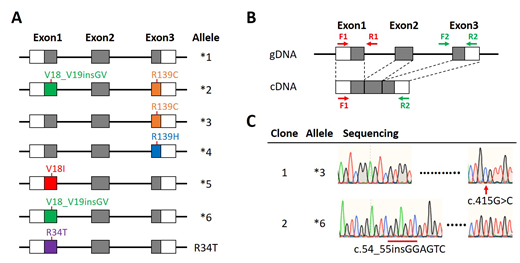Background: The NUDT15 polymorphisms, V18_V19insGV and R139C, located on exon 1 and exon 3 were associated with intolerance of 6-mercaptopurine (6MP), which were frequently used during the maintenance therapy of childhood acute lymphoblastic leukemia (ALL). However, these two NUDT15 diplotypes with significant different biological activity, mono-allelic *1/*2 and complex homozygosity *3/*6, could not be distinguished from each other by direct Sanger sequencing of exon 1 and exon 3. We applied targeted sequencing of NUDT15 cDNA to clarify the diplotypes of complex homozygous of NUDT15. Methods: Thirty-five ALL patients who were diagnosed in National Taiwan University Hospital with both V18_V19insGV and R139C of NUDT15 were included in this study. A single amplicon (562 bp) covers all the coding regions of NUDT15 was amplified from cDNA and then sequenced by paired-end sequencing using MiSeq reagent kit v3 (600 cycles). For validation, the amplicons from complex homozygous NUDT5 were cloned into pCR-Blunt II-TOPO vector. Result: By targeted sequencing, thirty-three patients were identified as mono-allelic *1/*2. Two complex homozygous NUDT15, *3/*6 and *2/R34T, were identified in patient No.27 and No.37. We also cloned amplicons from these two patients into vector and the results were the same as targeted sequencing. These two patients with complex homozygous NUDT15 variants tolerated only 1~2 mg/m2 daily mercaptopurine doses. Conclusions: Targeted sequencing of NUDT15 cDNA is a simple method to determine the NUDT15 diplotype and helpful for the identifications of complex homozygous NUDT15, which should be identified before the administration of 6MP to avoid excessive myelosuppression caused by improper of 6MP dosage. Figure: (A) NUDT15 haplotypes. (B) The primers is used for direct Sanger sequencing and cDNA targeted sequencing. (C) The NUDT15 diplotype of patient No.27 is analyzed using cDNA cloning followed by Sanger sequencing.
No relevant conflicts of interest to declare.
Author notes
Asterisk with author names denotes non-ASH members.


This feature is available to Subscribers Only
Sign In or Create an Account Close Modal